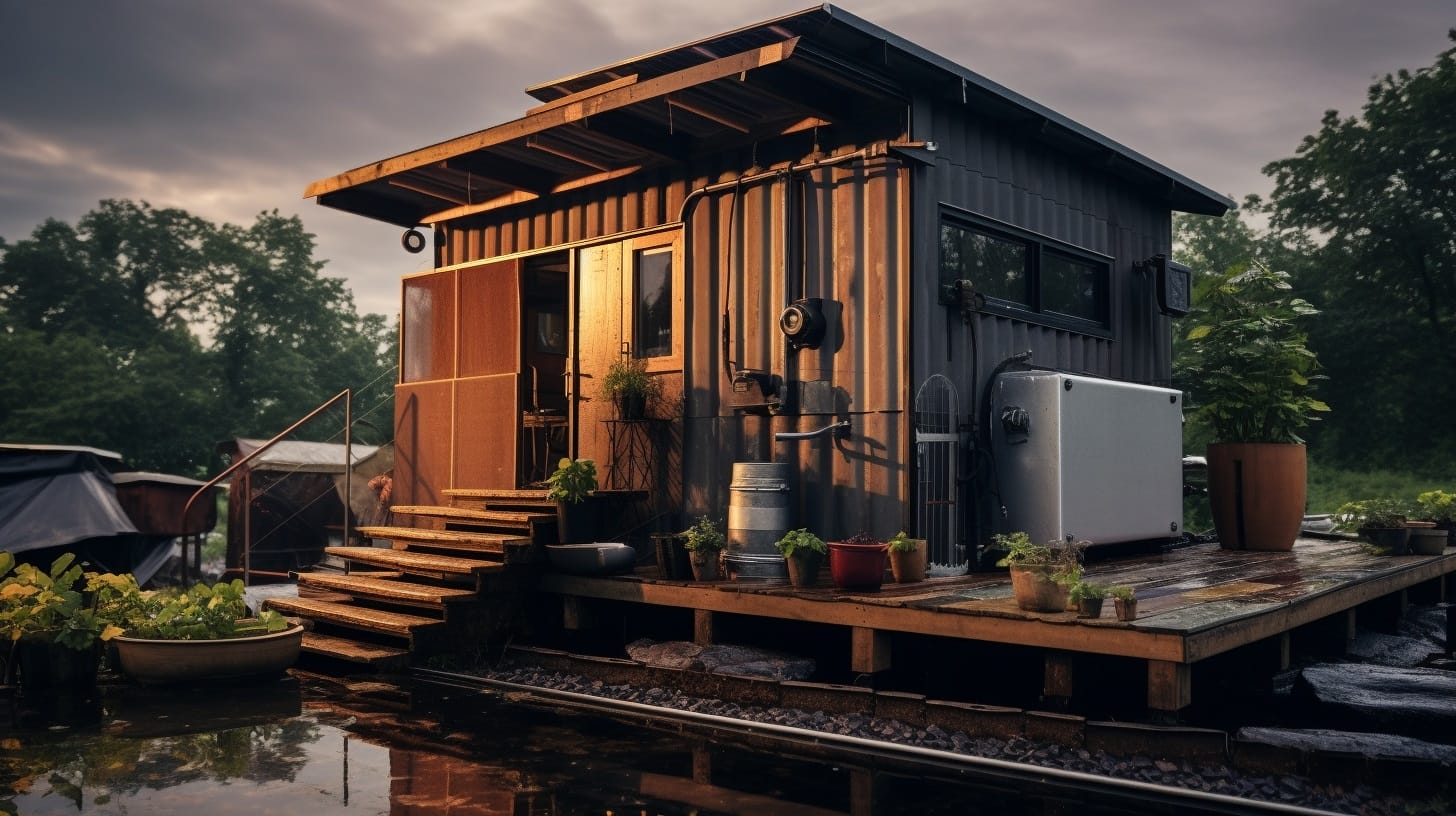Tiny living is inherently sustainable. But mindful designs allow maximizing eco-benefits by minimizing energy, water use, and waste.
Explore these 3 exceptional examples of eco-friendly tiny homes built using green materials and featuring energy-efficient systems. Discover how small design decisions can yield outsized environmental rewards.
1. Off-Grid Tiny With Rainwater Harvesting
This completely off-grid tiny home demonstrates sustainable self-sufficiency.
Green Materials – The structure incorporates reclaimed barn wood, recycled cardboard insulation, reclaimed windows, and locally milled pine. These materials were ethically sourced or reused to avoid new resource extraction.
Passive Solar – The house is sited and oriented to maximize southern exposure. Overhangs shade the windows in summer but allow low winter sunlight to passively heat the home.
Rainwater Catchment – All water needs are met through rainwater collection in a 2500 gallon underground cistern. This avoids municipal water use. Gutters and pipes direct roof runoff into the cistern.
Composting Toilet – A Nature’s Head dry composting toilet allows comfortable off-grid living without wasting water on sewage. Compost is used to fertilize the garden.
Solar Power – A rooftop 8 kW solar array provides more than enough renewable electricity. Excess power is stored in batteries or sold back to the grid.
This net-zero tiny home demonstrates sustainability through rainwater harvesting, passive solar design, and renewable energy systems powering a comfortably off-grid lifestyle.

2. Urban Micro-Apartment With Eco Upgrades
Even a small apartment-style tiny house in an urban area can achieve impressive sustainability through smart upgrades:
Efficient Appliances – Energy Star refrigerator, washer, stove and on-demand tankless water heater reduce energy and water consumption by 20-30%.
Low-Flow Plumbing – Low-flow faucets, showerheads and dual flush toilets conserve water usage by 30-60%.
LED Lighting – Energy efficient LED light bulbs use up to 80% less power than traditional bulbs. Lights are mainly powered by rooftop solar panels.
Insulation – Spray foam, insulated windows, and weatherstripping minimize air leaks and heat transfer, improving efficiency by up to 20%.
Urban Garden – A vertical hydroponic garden provides fresh produce. Compost bins recycle food waste into fertilizer.
Eco Materials – Countertops made from PaperStone recycled paper and bamboo flooring provide sustainable finishes.
With a small footprint and sustainable upgrades, this urban tiny home demonstrates comfort, beauty, and eco-friendliness don’t have to be sacrificed.

3. Off-Grid Cabin Using Reclaimed Materials
Nestled deep in the woods, this off-grid tiny cabin makes use of reused building materials and renewable energy:
Reclaimed Wood – The majority of the lumber, including exterior siding and interior paneling, was reclaimed from old barns and fencing. This avoids the need for new logging.
Salvaged Windows – Vintage windows help provide natural light and ventilation. Salvaging existing windows reduces manufacturing impacts.
Rainwater Catchment – Collected rainwater stored in a cistern provides the cabin with an independent water supply without tapping municipal resources.
Composting Toilet – The bathroom features a composting toilet to eliminate water usage and septic discharge.
Passive Solar – The cabin’s orientation, window placement, and thermal mass help regulate interior temperatures naturally with minimal heating and cooling required.
Solar Electricity – Rooftop solar panels generate all the renewable power needed for lighting, appliances and devices.
Reclaimed materials and off-grid systems allow this woodland tiny cabin to meet sustainability goals in an eco-friendly manner.

Eco-Friendly Tiny House Movement
The examples above showcase the massive sustainability potential of the tiny house movement. By downsizing to a smaller footprint and intentionally designing for eco-efficiency, tiny homes can:
- Use 40-75% less energy and water than conventional houses, reducing resource consumption.
- Incorporate salvaged and recycled building materials to divert waste from landfills.
- Employ passive solar techniques and insulation to decrease heating and cooling demands.
- Provide renewable power through solar, meeting electricity needs sustainably.
- Allow comfortable off-grid living through rainwater harvesting and composting toilets.
- Grow food and compost waste to close resource loops.
- Bring simplicity and mindfulness to combat overconsumption and clutter.
The small but mighty tiny house makes living lightly achievable and profound. Through creativity and commitment to sustainability, you too can design an eco-friendly tiny oasis.
FAQs on Eco-Friendly Tiny Homes
If exploring sustainable tiny living, here are helpful answers to a few frequently asked questions:
What are the best online resources for learning about green tiny house design?
Sustainability websites and blogs, Reddit communities like r/greenbuilding, tiny house magazines, green architecture reference manuals, and eco-building books contain a wealth of information.
What are the main benefits of an eco-friendly tiny house?
An eco-friendly tiny home will have a much smaller energy, water, and resource footprint. This saves money while reducing your personal environmental impact. A healthy, minimalist sustainable lifestyle is achievable.
What features should I prioritize for a green tiny house?
Focus first on passive solar design, insulation, renewable energy, water efficiency through rain harvesting and composting toilets, waste reduction, and eco-friendly materials.
How much more does an eco-friendly tiny house cost compared to conventional construction?
Depending on features selected, building sustainably may cost 10-25% more upfront, but provides long-term utility savings and priceless environmental benefits.
Can a tiny home be eco-friendly in any location and climate? Yes! You can incorporate sustainability through smart passive design, green features and materials, renewable energy, conservation practices, gardening, and mindful living anywhere.
Want to start living tiny and sustainably? Share the eco-friendly design or feature that excites you most in the comments below! And don’t forget to subscribe to our newsletter to receive more tiny house tips and inspiration right to your inbox.
